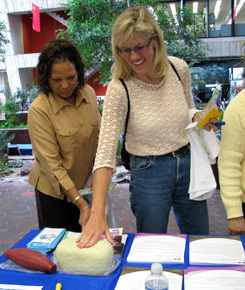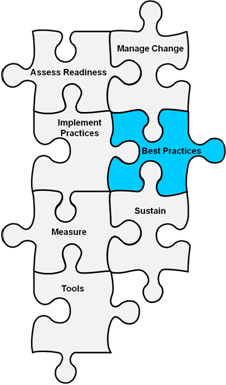Since 1951, the last full week (Sunday through Saturday) of September has been designated Deaf Awareness Week.
Deaf Awareness Week is a time to promote deaf culture and heritage and the use of American sign language. There will be programs across the nation, including library displays, open houses at residential schools and exhibit booths at shopping malls. The observance occurs during the week noting the 19th anniversary of signing into law of the Americans with Disabilities Act. More than 41 million people across the nation have some level of disability (about 15 percent of the population 5 and older). About 1 million adults report not being able to hear conversations at all. Nearly 60 percent of people age 21 to 64 with difficulty hearing have jobs.
Deaf Awareness Week Objectives
The purpose of Deaf Awareness Week is to educate communities about the many issues the deaf population face during everyday life, as well as to honor the history and culture of people who are deaf or hard-of-hearing...specifically:
- To differentiate between misconception and fact about deaf and hard of hearing people and deaf culture.
- To understand the differences in the attitudinal approaches to being deaf or hard of hearing by the hearing public and by deaf or hard of hearing people themselves.
- To learn about types, degrees, and causes of hearing loss and other audiological information.
- To become familiar with terminology related to being deaf or hard of hearing.
- To become familiar with sign language and other ways deaf and hard of hearing people communicate.
- To understand the functions of assistive devices used by people who are deaf or hard of hearing.
- To better understand an interpreter’s role.
- To learn about the types of educational programs and support services that are available to deaf and hard of hearing children.
- To gain an understanding of the psychosocial aspects of being deaf or hard of hearing.
- To become familiar with the services and resources that are available to the deaf and hard of hearing community.
- To learn about communicating with deaf and hard of hearing people.
- To have a better understanding of deaf culture.
- To recognize that “Deaf People Can Do Anything Except Hear!”
American Sign Language

American Sign Language (ASL) is a complete, complex language that employs signs made with the hands and other movements, including facial expressions and postures of the body. It is the first language of many deaf North Americans, and one of several communication options available to deaf people. ASL is said to be the fourth most commonly used language in the United States.
The exact beginnings of ASL are not clear. Many people believe that ASL came mostly from French Sign Language (FSL). Others claim that the foundation for ASL existed before FSL was introduced in America in 1817. It was in that year that a French teacher named Laurent Clerc, brought to the United States by Thomas Gallaudet, founded the first school for the deaf in Hartford, Connecticut. Clerc began teaching FSL to Americans, though many of his students were already fluent in their own forms of local, natural sign language. Today's ASL likely contains some of this early American signing. Which language had more to do with the formation of modern ASL is difficult to prove. Modern ASL and FSL share some elements, including a substantial amount of vocabulary. However, they are not mutually comprehensible.
Educating Your Neighbors about Deaf Awareness Week

Many of your neighbors may benefit from a better understanding of deaf neighbors and American Sign Language! The Deaf Awareness Week in September is an excellent opportunity to organize a deaf awareness educational event for your community.
If an organized event is not reasonable, consider creating an educational display for your health center, community center, pool, club house, park, or wherever your neighbors congregate.
Neighborhood Link suggests the teaching tools from the National Institute on Deafness and Other Communication Disorders.
These resources are produced by the U.S. Government and are therefore not bound by typical copyright laws. You may duplicate and distribute them in your efforts to educate your neighbors.
Free Publications To Use In Your Neighborhood
- American Sign Language (On-line only)
Information and resources concerning sign language, American Sign Language, comparisons between sign and spoken language, and language acquisition by deaf children. - Auditory Neuropathy
Information and resources concerning the hearing disorder auditory neuropathy.
Limit: 3 - Captions: For Deaf and Hard-of-Hearing Viewers
Information and resources concerning captions and captioning including: closed captioning, real-time captioning, captioning research, the FCC and captioning requirements.
Limit: 3 - Cochlear Implants
Information and resources concerning cochlear implants including an introduction, description of the device and its workings and discussions on who gets implants and how.
Limit: 3 - Cochlear Implants in Adults and Children, Consensus Statement (On-line only)
- Communication Considerations for Parents of Deaf and Hard-of-Hearing Children
Information, advice and resources for parents with deaf and hard-of-hearing children including: newborn screening, optimizing residual hearing and working with teachers.
Limit: 3 - Ear Infection (Otitis Media)
Information and resources concerning otitis media including: introduction, how we hear, effects, otitis media and children, preventing and treating otitis media.
Limit: 3 - Ear Infections: Facts for Parents
Fact sheet on otitis media aimed at parents with deaf and hard-of-hearing children. Includes information, advice, and resources.
Limit: 3 - Enlarged Vestibular Aqueducts and Childhood Hearing Loss
This fact sheet describes what scientists are discovering about the causes, diagnosis, and treatment of enlarged vestibular aqueducts (EVA). Although EVA does not appear to be the cause, research suggests that most children with this condition will develop some degree of hearing loss.
Limit: 3 - Facts About Telecommunications Relay Services
An overview of telecommunications relay services (TRS) including a discussion of the Americans with Disabilities Act (ADA) and 711 access instructions
Limit: 3 - Has Your Baby's Hearing Been Screened?
Information and resources concerning hearing screening for babies including when, where and how to screen and recognizing and coping with early childhood hearing loss.
Limit: 3 - Have WISE EARS! for Life. Protect Yourself and Your Family from Noise-Induced Hearing Loss (On-line only)
Information and resources concerning noise-induced hearing loss and hearing protection. - Hearing Aids
Information and resources concerning hearing aids including: hearing loss, types of hearing aids, hearing aid adjustment and care, and shopping for hearing aids.
Limit: 3 - Hearing Loss and Older Adults
Information and resources concerning hearing loss in older adults including: hearing loss test, dealing with hearing loss, and descriptions of treatments and devices.
Limit: 3 - How Health Professionals Can Encourage Follow-up Hearing Evaluations for Newborns
Screening is only the beginning of a successful path for infants who are deaf or hard-of-hearing.
Limit: 3 - How Loud Is Too Loud? Bookmark
Guide to noises that can cause ear damage. Page includes a “noise ruler” for measuring potentially damaging noise exposure.
Limit: 10 - More About Cochlear Implants...
This publication addresses the needs of potential cochlear implant users, current patients, families, and medical and health professionals. - The Noise in Your Ears: Facts About Tinnitus
Information and resources concerning tinnitus (noise in ears) including: causes, diagnosis, treatment, and self-help.
Limit: 3 - Noise-Induced Hearing Loss
Information and resources concerning noise-induced hearing loss including: causes, effects and symptoms of NIHL, who is affected by NIHL and NIHL prevention and research.
Limit: 3 - Otosclerosis
Information and resources concerning otosclerosis including: description, causes, symptoms, diagnosis, treatment, and research.
Limit: 3 - Pendred Syndrome
This fact sheet describes the causes, diagnosis, and treatment of Pendred syndrome, a genetic disorder that causes early and progressive hearing loss in children and also may affect the thyroid and the vestibular, or balance, system.
Limit: 3 - Presbycusis
Information and resources concerning presbycusis including: introduction, symptoms, causes, treatment, hearing aid selection, and communication tips.
Limit: 3 - Sudden Deafness
Information about rapid loss of hearing including: description, causes, treatment, and research.
Limit: 3 - Ten Ways To Recognize Hearing Loss Bookmark
Ten questions that will help you determine if you need to have your hearing evaluated by a medical professional.
Limit: 10 - Usher Syndrome
Information and resources concerning Usher syndrome including: description, who is affected, causes, types, characteristics, diagnosis, treatment, and research.
Limit: 3 - Waardenburg Syndrome (On-line only)
Information about this inherited disorder, including: types, causes, and research. - What to Do if Your Baby's Screening Reveals a Possible Hearing Problem
Next steps after a baby’s screening reveals possible hearing problems including: follow-up examinations, intervention services, follow-up checklists, and resources.
Limit: 3 - WISE EARS! At Work!
Information about protecting your ears at work to prevent noise-induced hearing loss. - WISE EARS! Tips (On-line only)
Information and tips about preventing noise-induced hearing loss.
 Print
Print Email
Email








